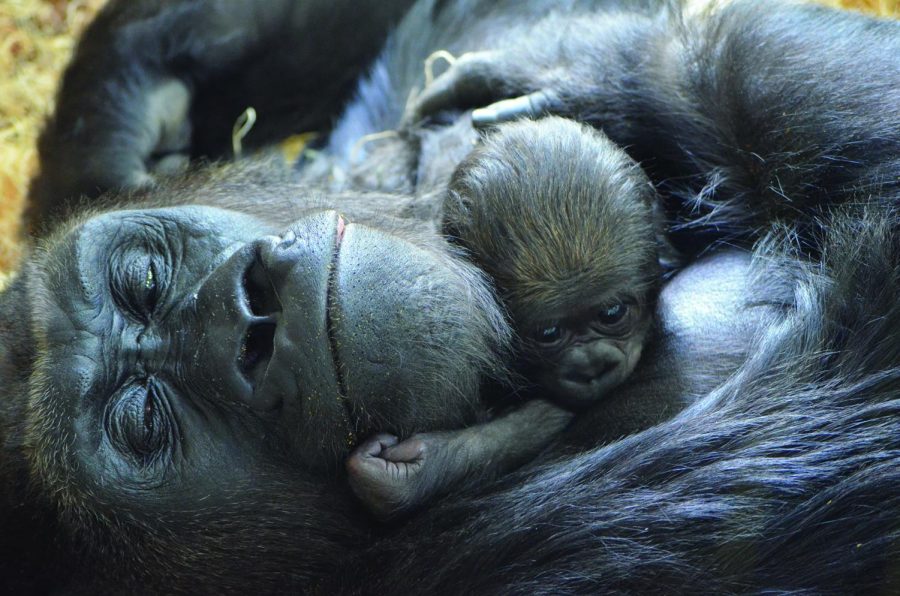Lincoln Park Zoo Welcomes Newborn Gorilla
Western lowland gorilla Bahati of Lincoln Park Zoo, 2001 N. Clark St., holds her daughter, Bella, who was born at the zoo Feb. 24. Maureen Leahy, primate curator at the zoo, said Bella spends her days nursing and sleeping.
March 9, 2015
BAHATI, A WESTERN lowland gorilla gave birth Feb. 24 at the Lincoln Park Zoo, allowing zoo visitors the opportunity to see the newborn named Bella beginning March 7.
The zoo, located at 2001 N. Clark St., collaborated with the Gorilla Spe- cies Survival Plan to identify the new- born’s father’s gorilla troop—a family group in which there is typically one or more adult male whose role is to protect the female offspring within the group, said Liz Williamson, vice chair for the gray tape section of the Pacific Long International Union for the Conservation of Nature and the Species Survival Commission primate specialist group.
The group will stay together un- til the gorillas are teenaged and ready to begin mating, at which point they part ways to ensure no inbreeding occurs among the apes, Williamson said.
Generally, the troops consist of 10– 20 gorillas who remain together for years. The role of the dominant male may change as the younger males mature, Williamson said.
“The new baby gorilla is cur- rently nursing and sleeping,” said Maureen Leahy, primate curator at zoo, in an emailed statement. “When she is awake, she is aware of her surroundings.”
Kwan, the newborn’s father, is very protective of Bahati and the baby,
Courtesy LINCOLN PARK ZOO Western lowland gorilla Bahati of Lincoln Park Zoo, 2001 N. Clark St., holds her daughter, Bella, who was born at the zoo Feb. 24. Maureen Leahy, primate curator at the zoo, said Bella spends her days nursing and sleeping.
38 • March 9, 2015
Leahy said. He said Kwan always sits near them, and if the baby’s two half-sisters, Patty and Nayembi, get too pesky or try to bother the infant, Kwan will gently guide them away.
Williamson said a female lowland gorilla will rarely let her infant out of her sight during its first year and that mothers in the wild are known to sac- rifice their own lives if it means pro- tecting the lives of their infants.
“When a baby dies, the mother will mourn the death of that infant by car- rying it for about a week until it is no longer recognizable as her baby,” Wil- liamson said.
Ray Wack, senior veterinarian at the Wildlife Health Center at the
Gorilla Doctors organization based at the University of California, Da- vis, whose primary mission is saving the mountain and eastern lowland gorilla species, said the difference be- tween gorillas raised in captivity and those raised in the wild is how they interact socially.
“In captive situations, the group is pretty solid,” Wack said. “Gorillas in the wild will be on the mother’s back as the troop moves through the forest.”
Lowland gorillas currently are at a high risk of extinction, according to Williamson.
“They have been classified as critically endangered, which is
the highest category on the [In- ternational Union for the Con- servation of Nature] red list,” Williamson said.
According to Williamson, in- cluding the lowland gorilla on the IUCN’s critically-endangered list means throughout the next three generations—or between 60 and 75 years—80 percent of their population faces the risk of extinction.
Williamson said the main surviv- al risks for western lowland gorillas are poaching and habitat remov- al. The rate at which the forest is disappearing is now increasing in Central Africa because of logging and mining for valuable minerals,
according to Williamson. She also said many people are unaware that Ebola has been a massive threat to gorillas. Some populations in the Republic of Congo have lost up to 90 percent of their members to Ebola, Williamson said.
“When there is an outbreak, the mortality rate in gorillas is higher than it is in humans,” Williamson said.
Gorillas are one of the most popu- lar animal attractions at the zoo, Wil- liamson said.
“They draw attention from the media, people love gorillas,” she said.








